Understanding sail area calculation is critical for optimizing your boat’s performance and ensuring that your onboard equipment functions efficiently. Sail area, along with boat length and ballast, plays a significant role in determining load-dependent systems. This makes accurate sail area calculation a vital step for sailors and a key criterion used by hardware manufacturers.
In this guide, we provide you with the essential rig and sail dimensions, along with the formulas necessary for precise sail area calculation. Mastering these calculations will help you optimize your sailing setup to achieve better performance on the water and ensure the right gear is in place.
Key Rig data
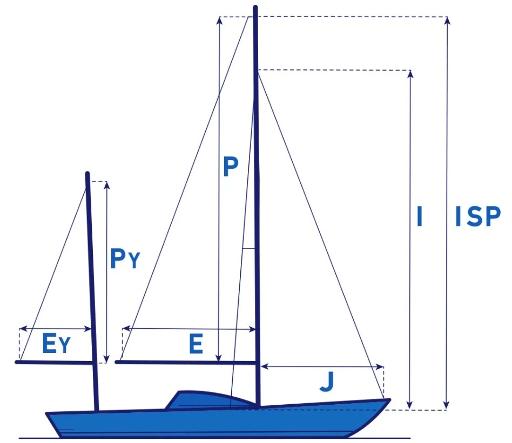
Source: North sails
I – Height of Foretriangle
Elevation of Forestay, measured down to elevation of main shrouds at sheer line.
J – Base of Foretriangle
Horizontal distance measured from front face of mast at deck to position of headstay at sheer line.
P – Mainsail Hoist
Elevation of upper mast band or maximum main halyard position, measured down to lower mast band or top of boom.
E- Mainsail Foot
Horizontal distance measured from aft face of mast at top of boom to boom band or maximum outhaul position.
Is – Height of Inner Foretriangle
Elevation of Forestay, measured down to elevation of main shrouds at sheer line.
Js – Base of Inner Foretriangle
Horizontal distance measured from front face of mast at deck to position of inner headstay at sheer line.
Py – Mizzen Mainsail Hoist
Elevation of upper mast band or maximum main halyard position, measured down to lower mast band or top of boom.
Ey – Mizzen Mainsail Foot
Horizontal distance measured from aft face of mizzen mast at top of boom to boom band or maximum outhaul position.
ISP – Elevation of Spinnaker Halyard
Measured down to elevation of main shrouds at sheer line.
SPL – Spinnaker Pole Length
STL – Spinnaker Tack Length
Horizontal distance measured from front face of mast at deck, forward and horizontally to position of spinnaker tack attachment point.
Key Sail measurement data
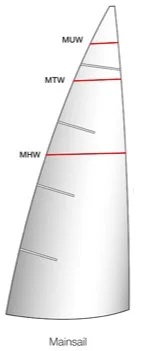
- MHB – Main Head Board width
- MUW – Main Upper Width at 7/8 height
- MTW – Main Third Width at 3/4 height
- MHW – main Half Width at 1/2 height
- MQW – Main Quarter Width at 1/4 height
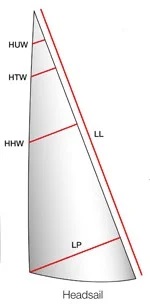
- HUW – Headsail Upper Width at 7/8 height
- HTW – Headsail Third Width at 3/4 height
- HHW – Headsail Half Width at 1/2 height
- LL – Luff Length
- LP – Luff Perpendicular (shortest distance from clew to luff)
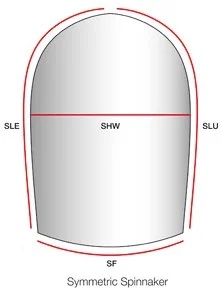
- SLE – Spinnaker Leech*
- SLU – Spinnaker Luff*
- *N.B. both the same on a symmetric spinnaker
- SHW – Spinnaker Half Width (distance from mid-point SLU to mid-point SLE)
- SF – Spinnaker Foot
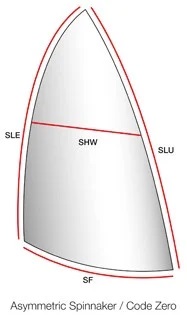
- SLE – Spinnaker Leech
- SLU – Spinnaker Luff
- SHW – Spinnaker Half Width (distance from mid-point SLU to mid-point SLE)
- SF – Spinnaker Foot
Basic Sail Area Calculation
Mainsail
P x E / 2 (no roach)
P x E x 0.585 (with roach)
Mizzen
Py x Ey / 2 (no roach)
Py x Ey x 0.585 (with roach)
Jib / Genoa
(I X J) / 2 x LP%
Example LP%: Full size genoa 1 – 150%, genoa 2 - 130%, genoa 3 – 105%, working jib – 85-95%
Spinnaker
(SL x (SHW + SF) / 2) x 0,95
More detailed sail area calculation
Sail area is a big thing for rating certificates. It is a hot area for debate with different rating organisations having their own small variations. However, despite their subtle differences they have similar principles and listed below are the Rated sail areas for the Offshore Rating Congress (ORC) (source ORC Rating Systems 2019):
Mainsail
Mainsail measured area is calculated by the simplified trapeze formula above, dividing the luff in amounts of 1/4, 1/2, 3/4 and 7/8.
Area =
P / 8
(E+2·MQW+2·MHW+1.5·MTW+MUW+0.5·MHB)
Headsail
Where HLU = Headsail Luff Length, HLP = Headsail perpendicular (LP) and HHB = Headsail head width
Area =0.1225·HLU·(1.445·HLP+2·HQW+2·HHW+1.5·HTW+HUW+0.5·HHB)
Symmetrical spinnaker
Area =
SLU·(SFL+4·SHW) / 6
Asymmetric spinnaker
First you need to calculate Average Spinnaker Luff (ASL)
ASL =
SLU+SLE / 2
Followed by the area
Area =
ASL·(SFL+4·SHW) / 6
Sail Area Calculation Summary
Basic main and headsail sail areas can be calculated from simple rig data whereas for a more accurate sail area calculation you need detailed measurements of your sail which you can either measure yourself or ask your sailmaker to supply.
If you would like to speak to an expert about your sailing systems and sail area calculation, please use the link below, or contact us at [email protected].


Sail Area Calculation: A Key Factor in Sailing Performance